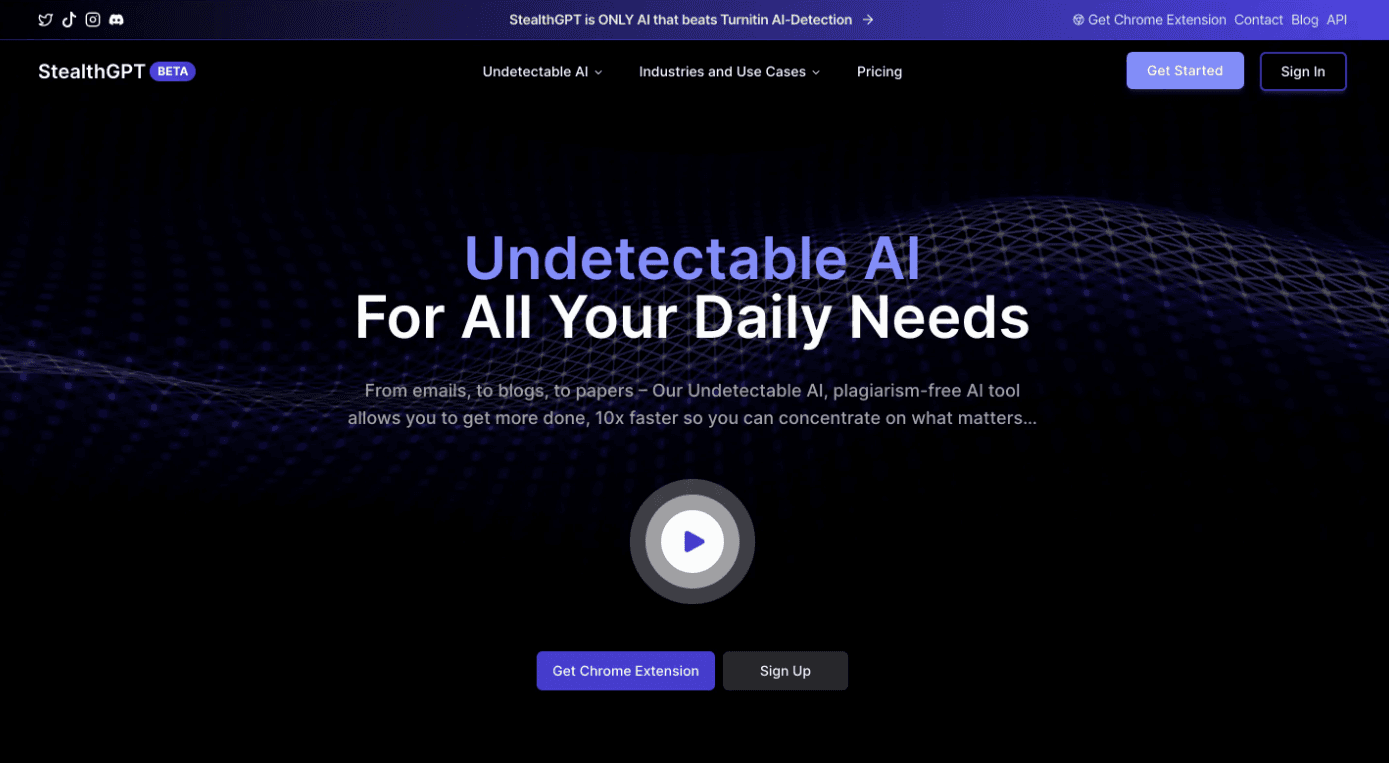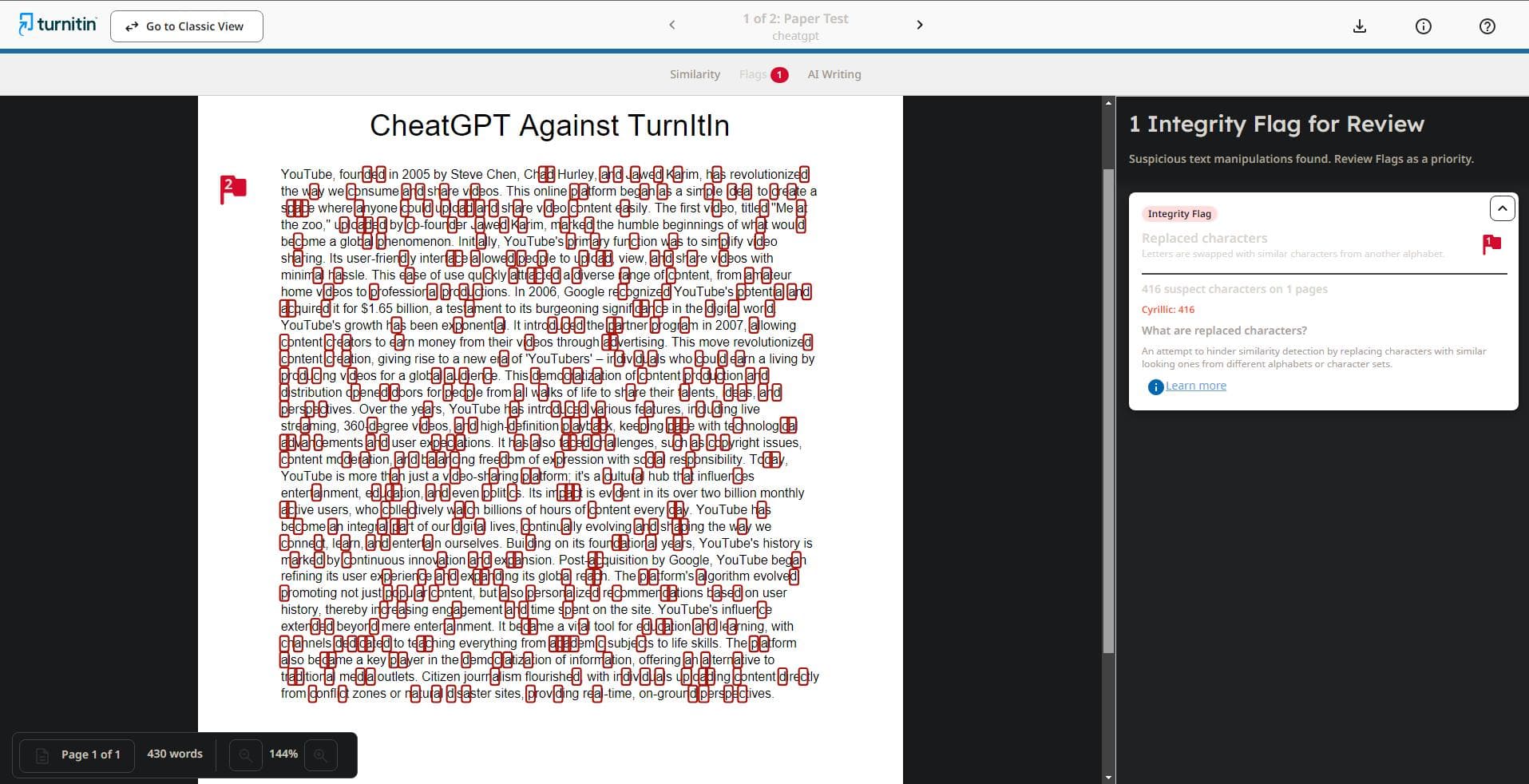Undetectable AI, Blog
Does CheatGPT Bypass TurnItIn?
In the ever-evolving landscape of academia, the use of Artificial Intelligence (AI) tools has become both a boon and a source of concern. With the rise of platforms like Turnitin designed to combat plagiarism, the question arises: Can CheatGPT bypass the watchful eyes of these sophisticated AI plagiarism detectors? To unravel this mystery, we embark on a journey into the realm of undetectable AI websites and introduce a contender in the ring - StealthGPT.
As students and researchers strive for academic excellence, the temptation to explore the capabilities of AI-driven text generators like CheatGPT becomes inevitable. The question lingers: Can such tools outsmart the advanced algorithms employed by plagiarism detection systems like Turnitin? Our investigation aims to shed light on the efficacy of CheatGPT in evading the watchful gaze of Turnitin, a stalwart in the fight against academic dishonesty.
Amidst the discussions surrounding AI and academic integrity, StealthGPT emerges as a noteworthy player. This tool, positioned as an undetectable AI website, claims to provide a shield against the prying eyes of plagiarism detection tools. As we delve into the intricacies of StealthGPT, we seek to understand its purported ability to bypass AI detection mechanisms, questioning whether it lives up to the claims of being an undetectable AI solution.
Undoubtedly, the emergence of undetectable AI websites has reshaped the way individuals interact with technology. These platforms, offering a cloak against traditional scrutiny, present a double-edged sword. On one hand, they empower users with unprecedented capabilities, while on the other, they raise concerns about the potential misuse and erosion of academic integrity. We explore the implications of these undetectable AI tools in today's world and question their role in shaping the future of education.
In the pursuit of truth, our journey leads us to a pivotal question: Can StealthGPT truly bypass AI detection tools? As we uncover the intricacies of this undetectable AI website, we invite scrutiny, discussion, and validation. Does the tool live up to its claims, or is it another mirage in the vast desert of AI possibilities? The answer may not only shape our understanding of academic integrity but also offer insights into the evolving dynamics of technology's role in education. Join us in this exploration as we seek to demystify the intersection of AI, plagiarism detection, and the promises of undetectable tools.
Table of Contents
What is TurnItIn?
What are Undetectable AI Websites?
What is CheatGPT?
What is StealthGPT?
Test Preparation
CheatGPT Against TurnItIn
StealthGPT Against TurnItIn
Final Thoughts
CheatGPT vs StealthGPT’s Value and Pricing
CheatGPT vs StealthGPT's value
What is TurnItIn?

Turnitin is a widely recognized online tool designed to support academic integrity and foster original work in educational settings. Established in 1998, Turnitin has evolved to offer a range of features and services that cater to different aspects of academic and research integrity. Here's an overview of Turnitin, its features, characteristics, and its use in today's world.
Features and Characteristics
Plagiarism Detection: Turnitin's core functionality is its ability to check for plagiarism. It compares submissions against a vast database of academic works, student papers, and web pages to identify similarities and potential plagiarism.
Feedback Studio: This tool helps educators provide meaningful feedback on student writing. It not only checks for originality but also allows for in-depth comments and suggestions, fostering writing excellence.
Originality: Aimed at addressing the originality of student work, this feature detects emerging trends in academic misconduct, including text similarity, synonym swapping, and more sophisticated forms of plagiarism.
Gradescope: This modern assessment platform transforms the grading process, enabling efficient workflows and providing actionable student data. It’s particularly useful for grading paper-based, bubble sheet, and code assignments.
ExamSoft: Turnitin offers ExamSoft for on-campus and remote programs, addressing potential gaps in curriculum and assessment, and preparing students for their careers.
Similarity: A comprehensive plagiarism checker, Turnitin Similarity integrates seamlessly into existing workflows, upholding academic integrity.
iThenticate: This is a plagiarism checker designed for researchers and publishers, ensuring the originality of scholarly works before high-stakes publication.
AI Writing Detection: Turnitin has developed technology to identify submissions created using AI writing tools, a growing concern in academic circles.
Use in Today's World
In today's academic environment, where the accessibility of information and the rise of digital learning tools have changed the landscape of education, Turnitin plays a crucial role:
Promoting Academic Integrity: It helps maintain a culture of honesty and originality in academic institutions. By detecting plagiarism, Turnitin ensures that students' work is their own and helps educators uphold academic standards.
Enhancing Learning and Feedback: Through tools like Feedback Studio and Gradescope, Turnitin aids in providing constructive feedback and efficient grading, thereby enhancing the learning experience for students.
Supporting Research Integrity: For researchers and publishers, tools like iThenticate ensure the originality and credibility of scholarly publications.
Adapting to Technological Advances: With features like AI Writing Detection, Turnitin is evolving to meet the challenges posed by new technologies in education, ensuring that the tool remains relevant and effective.
Global Reach: Turnitin's services are used by educational institutions around the world, reflecting its global impact on maintaining academic standards and integrity.
Turnitin is a multifaceted tool that has become integral to modern education systems. Its ability to check for plagiarism, provide meaningful feedback, and adapt to new challenges makes it a valuable asset in promoting academic integrity and enhancing the educational process.
What Are Undetectable AI Websites?
Undetectable AI websites represent a cutting-edge evolution in the digital realm, where Artificial Intelligence (AI) systems operate behind the scenes, seamlessly integrating with human-driven content and interactions. These websites are "undetectable" in the sense that their AI components are so well integrated and human-like in behaviour that users may not realise they're interacting with AI at all.
At the heart of undetectable AI websites is advanced machine learning technology, which enables these platforms to learn from and adapt to user interactions. This can range from personalised content curation to dynamic user interface adjustments based on individual user preferences or behaviour patterns. The AI can analyse vast amounts of data in real-time, allowing it to anticipate user needs or respond to queries with a level of accuracy and speed that mimics human intelligence.
One of the key features of such websites is their natural language processing capabilities. This allows the AI to understand and respond to user inputs in a way that feels natural and intuitive. Whether it's through chatbots, search functions, or interactive tools, the AI can engage in a way that is indistinguishable from human interaction.
Another significant aspect is the AI's ability to generate content. Using algorithms capable of processing existing data and trends, these websites can produce original, relevant, and engaging content, be it written articles, visual designs, or multimedia elements. This not only enhances the user experience but also keeps the content fresh and up-to-date.
Ethically, undetectable AI websites raise important questions. The seamless nature of AI integration means users might not always know when they're interacting with a machine. This raises issues around transparency and consent, especially in areas like data privacy and personalization.
In summary, undetectable AI websites are a technological marvel, blending advanced AI with user interfaces in a way that makes the technology invisible to the user. They offer a glimpse into a future where human and artificial intelligence coexist seamlessly, yet they also caution us to consider the ethical implications of such deep integration.
What is CheatGPT?

CheatGPT, as implied by its name, seems to be a variant or a tool related to GPT (Generative Pre-trained Transformer) models like myself, ChatGPT. Given the "cheat" aspect in its name, it might be designed to serve specific purposes that could be considered as 'cheating' in certain contexts, such as bypassing plagiarism detection, evading AI detection systems, or assisting in activities that are normally restricted or monitored by AI tools.
Features and Characteristics:
AI-Based Text Generation: Like other GPT models, CheatGPT would likely have the ability to generate text based on prompts given to it. This can include writing essays, creating reports, or composing emails.
Evasion Techniques: CheatGPT might incorporate techniques to alter its writing style or content in a way that can bypass AI detection systems. This could be useful for users trying to pass AI-generated text as human-written in environments where AI assistance is not allowed.
Use our Free AI Detector to check your content
Customization Options: The tool may offer customization features that allow users to tailor the output to meet specific requirements or to mimic a certain writing style.
Language Understanding: As with other AI models, CheatGPT would be expected to have a good understanding of natural language, making it capable of engaging in coherent and contextually appropriate conversations or text generation.
Use in Today's World:
Academic Assistance: Students might use CheatGPT to help with writing papers or doing homework, especially in scenarios where they need to submit work that doesn’t appear to be AI-generated.
Content Creation: Writers and content creators might use it to generate initial drafts or ideas, especially when they need content that doesn't seem to be created by an AI.
Bypassing Restrictions: In environments where the use of AI tools is restricted or monitored, CheatGPT could potentially be used to circumvent these limitations.
Ethical Considerations:
It’s important to note that the use of tools like CheatGPT raises significant ethical concerns. Bypassing AI detection can be considered dishonest or deceptive, especially in academic or professional settings. Users should be aware of the ethical implications and the potential consequences of using such tools in contexts where honesty and originality are expected.
CheatGPT appears to be a specialised tool based on AI text-generation technology, potentially designed to evade AI detection systems. While it might offer practical benefits in various scenarios, its use comes with important ethical considerations that should not be overlooked.
What is StealthGPT?

StealthGPT is an innovative artificial intelligence tool designed for the generation of high-quality, AI-created content that is indistinguishable from human writing. It's part of the Generative Pre-trained Transformers (GPT) family but stands out due to its unique capability to produce outputs that are undetectable by AI detection software. This feature makes StealthGPT particularly valuable for a range of applications, including academic writing, professional content creation, and creative storytelling.
Features and Characteristics of StealthGPT
Advanced Language Processing: Trained on extensive datasets, StealthGPT possesses a sophisticated natural language processing capability. It understands context, interprets nuances, and generates human-like text, adapting to various writing styles and subjects.
Mimicry of Human Writing Styles: The AI can adjust its writing style and tone, employing idiomatic expressions and natural language variations, which helps its output closely resemble human writing.
Evasion of Detection: StealthGPT varies its writing patterns and uses content randomization to avoid detection by AI content detectors. This includes altering sentence structures and using diverse vocabulary.
Customization and User Input: It tailors output based on user instructions, keywords, or stylistic preferences. The AI also uses feedback loops for continuous improvement.
Integration with Data and Research: StealthGPT is capable of integrating and synthesising data from various sources, useful for research-heavy tasks. It performs basic fact-checking to ensure the accuracy of information.
Multilingual Support: StealthGPT can generate text in multiple languages, making it useful for global businesses.
Untraceable Interaction with GPT3: The platform emphasises maintaining user privacy and offers untraceable interactions with GPT3, ensuring conversation without fear of censorship or detection.
Flexible and Versatile Platform: StealthGPT is adaptable for various use cases, including long-form content creation and more narrowed tasks.
Uses in Today's World
Content Creation: StealthGPT assists in generating high-quality content for marketing, such as product descriptions, social media posts, and email newsletters, with minimal effort.
Academic Writing and Research: Students and academics can use StealthGPT for study aids, drafts, or learning, particularly in environments where AI detection tools are prevalent.
Professional Applications: Legal professionals, business professionals, journalists, and bloggers can use StealthGPT for drafting documents, reports, and articles. The tool ensures that the content does not trigger AI detectors used in formal review processes or violates ethical journalistic standards.
Creative Writing: Novelists and storytellers can use StealthGPT for generating ideas, dialogues, and narratives while keeping the AI’s involvement undetectable, thus retaining the authenticity of their work.
Global Business Communications: Its multilingual capabilities make it an essential tool for global businesses that need to produce content in different languages.
Text Completion: Useful in applications like word processors, emails, and text messages, where it can predict words or entire sentences to complete given sentences.
StealthGPT emerges as a powerful AI tool in today's digital landscape, offering a unique blend of undetectability, versatility, and high-quality text generation. It addresses the growing need for authentic AI-generated content across various sectors while ensuring privacy and customization. As the technology continues to evolve, it is likely to become an indispensable tool in various industries, revolutionising the way we approach content creation and AI-assisted tasks.
Test Preparation
Firstly, let's come up with a text written by ChatGPT. Here's the prompt that we will be using for the experiment.

Let's copy this text from ChatGPT and use CheatGPT’s humanizer tool for the experiment.

CheatGPT Against TurnItIn


For the first time, there is an unprecedented event occurring. TurnItIn, a plagiarism detection tool, is unable to identify CheatGPT's AI detection score. Nevertheless, it does flag instances of unusual text manipulation, which suggests an attempt by CheatGPT to evade TurnItIn. Although the exact implications are unclear, it appears that CheatGPT tries to bypass TurnItIn but is ultimately detected in the attempt.
Let's input that same text from ChatGPT into the StealthGPT system. After pasting, you'll see the Stealth writing which can bypass AI detection.
StealthGPT Against TurnItIn


StealthGPT continues to break all odds and achieves over 0% AI written content on TurnItIn. Proving itself as a capable AI bypass tool against TurnItIn.
Final Thoughts
In the dynamic world of academia, the rise of advanced AI tools like StealthGPT presents both opportunities and challenges. StealthGPT, an undetectable AI website, stands at the forefront of this evolution, offering capabilities that question the effectiveness of plagiarism detectors such as Turnitin. Our exploration delves into the complexities of tools like CheatGPT and StealthGPT, both designed to generate AI-driven text while evading detection by sophisticated AI plagiarism detectors.
StealthGPT, with its advanced language processing and ability to mimic human writing styles, emerges as a revolutionary tool. It offers a myriad of applications, from academic writing to professional content creation, while promising to remain undetected by AI detection software like Turnitin. This capability not only showcases the tool's technological prowess but also ignites a debate on the ethical implications of using such AI tools in academic and professional settings.
The question of whether StealthGPT can truly bypass AI detection tools like Turnitin remains pivotal. Our investigation reveals that while StealthGPT shows promise in evading detection, it also raises concerns about academic integrity and the potential misuse of AI in education. The tool's versatility and adaptability make it a valuable asset in various sectors, yet its use in academia must be approached with caution and responsibility.
As we embrace the advancements in AI technology, it is crucial to maintain a balance between innovation and ethical considerations. StealthGPT represents a leap forward in AI capabilities, but it also serves as a reminder of the need for transparency and integrity in the digital age. Its emergence challenges us to rethink the role of AI in education and the ongoing pursuit of academic honesty.
In conclusion, while StealthGPT showcases remarkable technological advancements, it also underscores the importance of using AI responsibly. Its potential to bypass AI detection tools like Turnitin opens up new possibilities but also necessitates a dialogue about the ethical use of AI in academic settings. As we navigate this evolving landscape, the focus should remain on harnessing AI's power for positive and ethical applications.
CheatGPT vs StealthGPT's Value and Pricing
CheatGPT Pricing

StealthGPT Pricing


Starting at $14.99 per month for 100,000 Undetectable AI words, 1 user, and with chrome extension. $19.99 for 500,000 words per month and $29.99 for 1,000,000 words per month. An annual option of $99.99 for 100,000 words per month, $199.99 for 500,000 words per month, and $299.99 for 1,000,000 words per month.
CheatGPT vs StealthGPT's value
CheatGPT provides an affordable option for users, priced at $5 for unlimited prompts. However, concerns arise about the legitimacy of their service, as there is only one plan available, and obtaining the premium version requires emailing them. This lack of clarity raises questions about subscription management, payment security, and the duration of access to the bypass tool, with the website failing to address these crucial aspects. Such uncertainties regarding privacy use and the website's legitimacy may cause reservations among users.
In contrast, StealthGPT offers transparent plans with clear information for users. Additionally, StealthGPT's bypass tool effectively counters popular AI detectors. While CheatGPT may initially attract users with its pricing, the absence of transparency and the tool's inability to bypass AI detectors should be considered. Ultimately, StealthGPT stands out as the preferred choice due to its clear pricing structure, value, and effectiveness against AI detectors.
If you're a high school or college student seeking an undetectable AI tool to enhance your writing, StealthGPT is the top choice. It surpasses major AI detectors like TurnItIn, providing a simple and user-friendly experience. The abundance of evidence supporting its effectiveness ensures your confidence in remaining undetected. Give StealthGPT a try today!